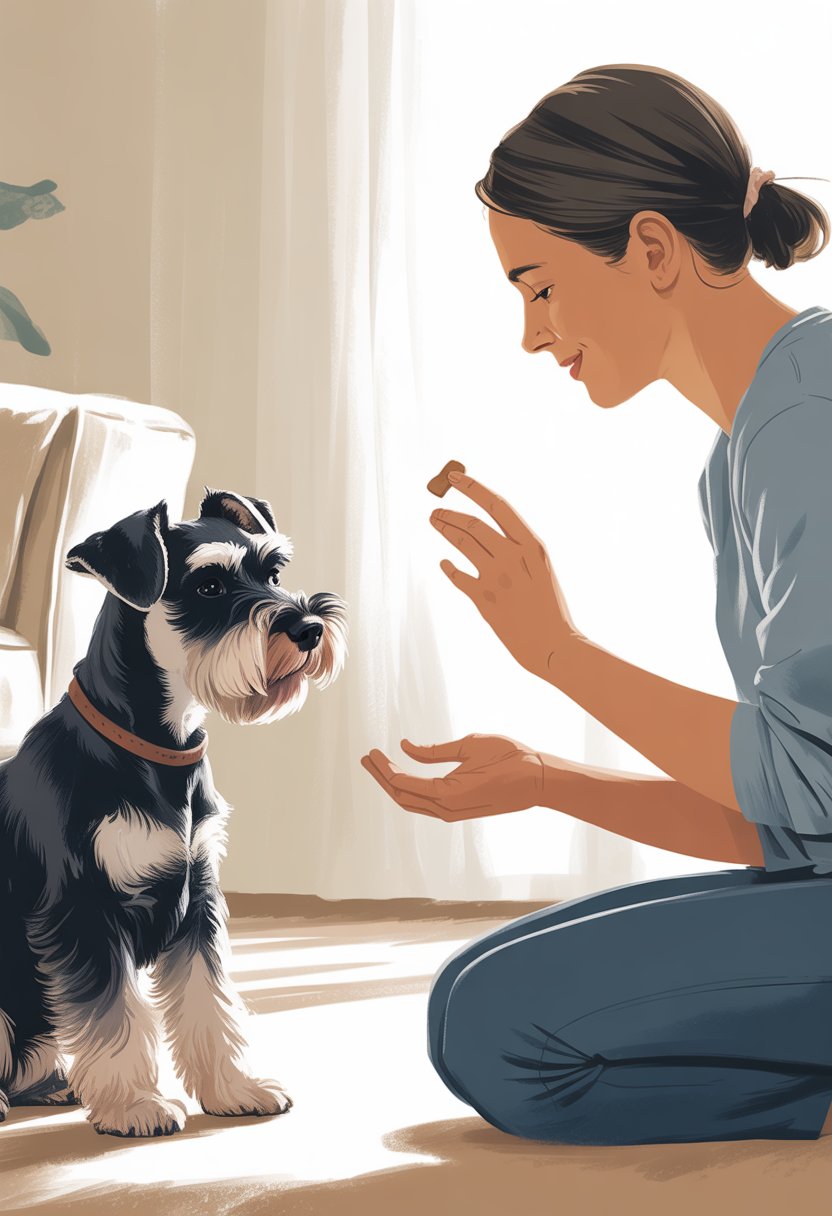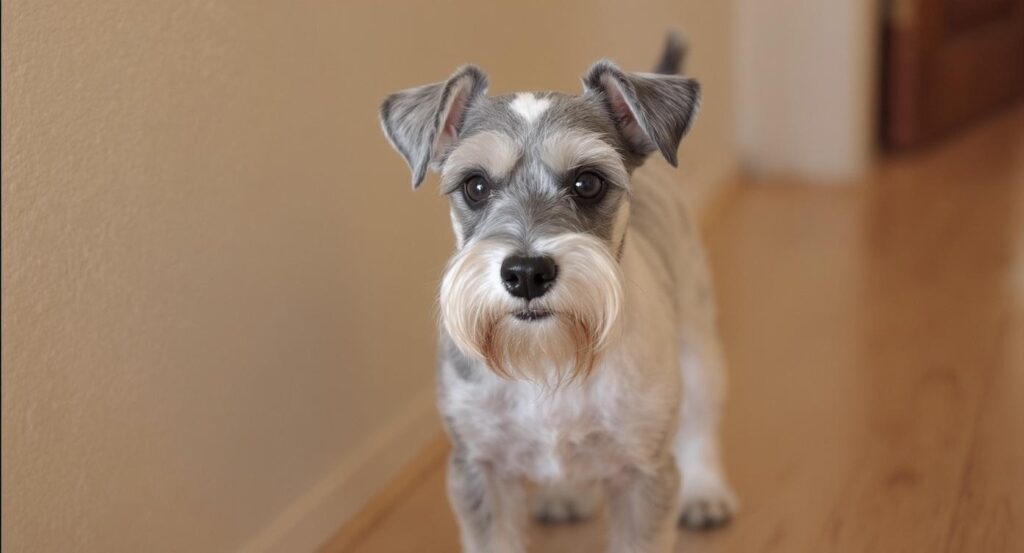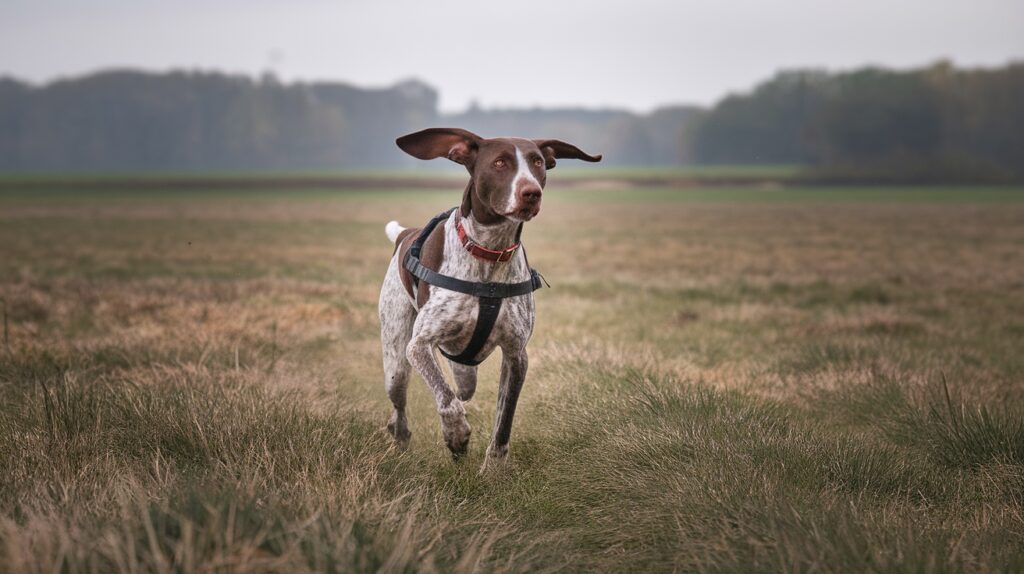Training a Miniature Schnauzer can feel both exciting and challenging. These dogs are smart, full of energy, and quick to pick up on patterns.
That makes them great learners when you use the right approach. Clear command strategies give you the tools to guide their behavior while building a stronger bond.
You’ll discover how simple steps like using short commands, rewarding good behavior, and keeping sessions fun can make a big difference. If you focus on consistency and understand their personality, you set the stage for smoother training and a happier daily routine.
Start with simple commands like ‘sit’ and ‘stay’ using treats as motivation.
When you first start training your Miniature Schnauzer, keep it simple. Begin with commands like “sit” and “stay” because they’re easy for your dog to understand and practice every day.
Hold a small treat in your hand and let your dog sniff it. Raise the treat slightly above their head so they naturally sit down while looking up.
As soon as they sit, say “sit” and give them the treat. For “stay,” ask your dog to sit first.
Hold your hand out like a stop sign and say “stay.” Take a small step back, and if your dog stays put, reward them right away.
Keep training sessions short, just a few minutes at a time. Your Schnauzer will stay more focused, and you’ll both avoid frustration.
Use a happy voice and lots of praise along with treats. This helps your dog connect the command with something positive.
Repeat these steps daily, and your Miniature Schnauzer will start to respond faster. Consistency is what helps the commands stick.
Keep training sessions short and fun to match their attention span
Miniature Schnauzers are smart, but they don’t stay focused for long. If you push training too long, they’ll get bored or distracted.
Short sessions keep them interested and willing to learn. Aim for just a few minutes at a time.
Three to five minutes is usually enough to teach or practice one skill. You can repeat sessions a few times a day instead of trying to do it all at once.
Mix in play or a quick break between training rounds. This helps your dog reset and stay excited about learning.
A little fun keeps the training from feeling like work. Use rewards right away when your dog gets it right.
A treat, toy, or simple praise makes them connect the behavior with something positive. Keeping it light and rewarding helps them look forward to the next session.
When you match the training to their attention span, you avoid frustration for both you and your dog. Short, fun lessons build confidence and help your Miniature Schnauzer remember what you taught.
Use clear, single commands to avoid confusion
When you train your Miniature Schnauzer, stick to one word or a short phrase for each action. Long or mixed commands make it harder for your dog to understand what you want.
Simple words like “sit” or “stay” work best. If you say different versions of the same command, your dog may not know which one to follow.
For example, switching between “come here” and “come” can slow learning. Pick one version and use it every time.
Consistency matters as much as clarity. If everyone in your home uses the same word for the same action, your Schnauzer will respond faster.
This avoids mixed signals that can confuse your dog. Keep your tone calm and steady.
A sharp or rushed voice may distract your dog from the actual word. Clear, single commands make it easier for your Schnauzer to connect the sound with the action you expect.
Reward good behavior immediately with praise or treats
When your Miniature Schnauzer follows a command, reward them right away. Quick rewards help them connect the action with the positive outcome.
If you wait too long, they might not understand what behavior earned the reward. You can use small treats, a cheerful “good job,” or even a quick play session.
Keep the rewards simple and consistent so your dog learns faster. Praise works well when you don’t want to rely on food every time.
Start with treats for new or harder commands since they grab your dog’s attention. As your Schnauzer gets better, you can mix in praise or petting instead.
This keeps training balanced and prevents overfeeding. Always keep rewards short and clear.
A snack, a pat, or a happy tone is enough. The goal is to make your dog want to repeat the behavior without confusion.
Be consistent with rules and routines every day
Your Miniature Schnauzer learns best when you keep the same rules every day. If you let them jump on the couch one day but not the next, they get confused.
Clear and steady rules make it easier for them to understand what you expect. Daily routines also help your dog feel secure.
Feeding, walking, and training around the same times give them structure. When they know what’s coming, they’re less likely to act out or test boundaries.
Stick to the same commands and tone of voice. If you say “sit” one day and “sit down” the next, your dog may not connect the two.
Using one clear word each time builds stronger habits. Consistency also means following through.
If you set a rule, such as no begging at the table, you need to enforce it every time. Skipping even once can undo progress and encourage unwanted behavior.
Keeping rules and routines steady takes some patience, but it pays off. Your Miniature Schnauzer will respond faster, behave better, and feel more comfortable when they know exactly what to expect from you each day.
Mix up training exercises to keep their smart minds engaged.
Your Miniature Schnauzer is quick to learn, so repeating the same drill every day can get boring fast. Switching up activities keeps them interested and helps them stay focused.
Variety also gives you a chance to work on different skills without overwhelming them. You can rotate between short obedience sessions, puzzle toys, and simple games like fetch or hide-and-seek.
These changes challenge their memory, problem-solving, and attention in different ways. It also makes training feel more like play than work.
Try adding new commands once they’ve mastered old ones. Even small changes, like practicing in a new room or outside, keep their brain active.
They’ll enjoy the fresh challenge, and you’ll see better engagement. Mixing mental and physical tasks works well too.
A short walk followed by a quick training game can help burn energy while sharpening focus. Keeping sessions short and varied will make your Schnauzer eager to learn each time.
Avoid harsh punishments to build trust and cooperation

When training your Miniature Schnauzer, it’s important to stay calm and patient. Yelling or using physical punishment can make your dog fearful instead of cooperative.
Fear often leads to more stubborn behavior, not less. Your Schnauzer learns best when you guide them with clear commands and consistent routines.
If you correct mistakes gently and redirect their attention, they’ll understand what you want without feeling threatened. Positive reinforcement, like treats or praise, helps your dog connect good behavior with rewards.
This builds trust and encourages them to listen to you more willingly. By avoiding harsh punishments, you show your Schnauzer that training is safe and fair.
This makes them more likely to follow your lead and stay engaged in learning.
Why Clear Commands Matter for Miniature Schnauzers
Miniature Schnauzers are smart, active, and quick to pick up patterns. When your commands are clear and consistent, you reduce confusion and build trust.
Understanding Miniature Schnauzer Temperament
Your Miniature Schnauzer is intelligent and eager, but also known for being a little stubborn. This mix makes them fast learners when training is fun and structured.
But they can also test limits if you’re not consistent. Because they thrive on mental stimulation, unclear or inconsistent commands can leave them frustrated.
If you change the wording or tone, your dog may not understand what you want, leading to slower progress. These dogs respond best to positive reinforcement.
Using treats, praise, or play keeps them motivated and focused. A clear command paired with a reward helps them connect the action to the outcome.
To keep them engaged, you should also vary training sessions. Schnauzers get bored with repetition, so mixing up the environment or order of commands helps them stay sharp.
Common Communication Mistakes
One of the biggest mistakes is using different words for the same action. For example, saying “come here” one day and “come” the next makes it harder for your dog to link the word with the behavior.
Another common slip is repeating commands too many times. If you say “sit, sit, sit” in a row, your Schnauzer may learn to wait until the third repeat instead of responding right away.
Tone of voice also matters. A command should be firm and clear, not shouted or mumbled.
Mixed signals, like smiling or laughing while correcting behavior, can confuse your dog and weaken your training. Consistency between family members is key.
If everyone uses the same words and rules, your Schnauzer learns faster and avoids mixed messages.
Quick Fixes for Clarity:
- Pick one word per command
- Avoid repeating commands
- Keep tone steady and clear
- Make sure all family members use the same cues
Tips for Reinforcing Command Strategies
Your Miniature Schnauzer learns best when you give clear rewards for good behavior and keep your training routine steady. Small changes in how you respond or the timing of your sessions can make a big difference in how quickly your dog understands and follows commands.
Using Positive Reinforcement
Reward your Schnauzer when they get it right. Grab a few small treats, offer some praise, or hand over a favorite toy right after your dog listens to a command.
The reward has to come quickly so your dog links the action and the treat. Don’t wait around—timing matters.
Switch up the rewards to keep things interesting. For example:
| Command | Reward Option |
|---|---|
| Sit | Small treat |
| Stay | Gentle praise |
| Come | Tug toy play |
Keep rewards brief and simple. You don’t need a big fuss—just enough so your dog knows, “Hey, I did it!”
Skip the punishment if they mess up. If your Schnauzer misses the mark, just reset and try again. It’s less stressful for both of you that way.
Consistency in Training Sessions
Your dog learns faster when you use the same words and gestures every time. If you say “sit” one day and “sit down” the next, you’ll probably just confuse your Schnauzer.
Pick one clear command for each action, and stick with it.
Keep training sessions short—around 5 to 10 minutes. Schnauzers have tons of energy, but they lose focus if you drag things out.
Try a few short sessions throughout the day instead of one long one. It really works better.
Make sure everyone in your home uses the same commands. If you say “off” but someone else says “down,” your dog won’t know what you want.
Honestly, it helps to write down the commands so everyone stays on the same page.



